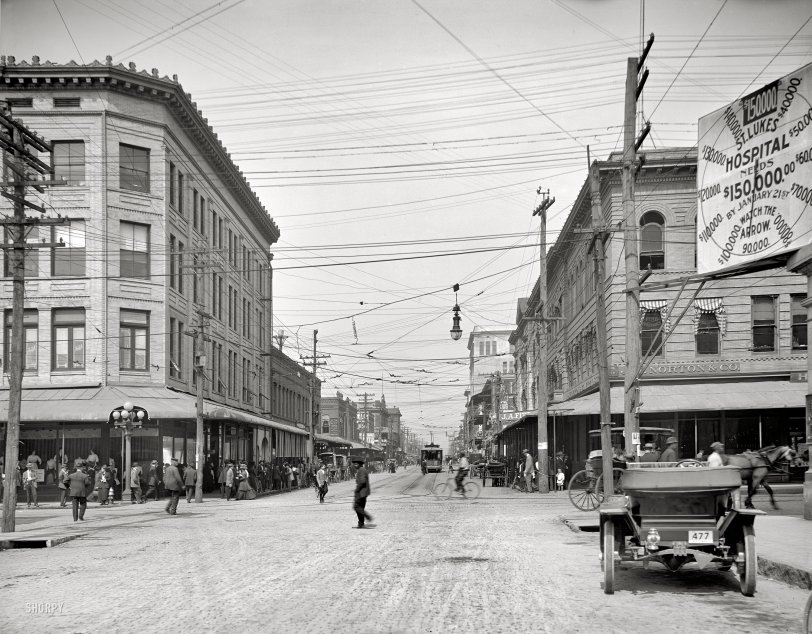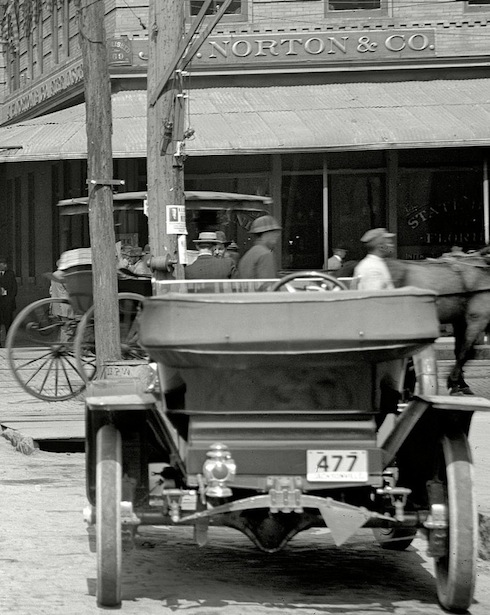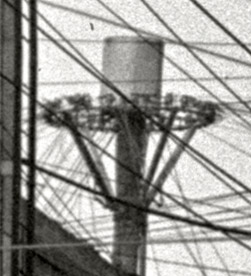


Framed or unframed, desk size to sofa size, printed by us in Arizona and Alabama since 2007. Explore now.
Shorpy is funded by you. Patreon contributors get an ad-free experience.
Learn more.

- What a headache!
- Baldwin 62303
- Baldwin VO-1000
- Cold
- No expense spared
- Tough Guys
- Lost in Toyland
- And without gloves
- If I were a blindfolded time traveler
- Smoke Consumer Also Cooks
- Oh that stove!
- Possibly still there?
- What?!?
- $100 Reward
- Freeze Frame
- Texas Flyer wanted
- Just a Year Too Soon
- WWII -- Replacing men with women at the railroad crossing.
- Yes, Icing
- You kids drive me nuts!
- NOT An Easy Job
- I wonder
- Just add window boxes
- Icing Platform?
- Indiana Harbor Belt abides
- Freezing haze
- Corrections (for those who care)
- C&NW at Nelson
- Fallen Flags
- A dangerous job made worse
Print Emporium
Jacksonville: 1910

Jacksonville, Florida, circa 1910. "Main Street north from Bay." 8x10 inch dry plate glass negative, Detroit Publishing Company. View full size.
Main and Bay Streets
This is Main Street (U.S. 17) looking north. I lived about five blocks north at the corner of Duval and Main during WW2. The building on the left was Sears and the building on the right eventually became Penney's. Both have been replaced by larger buildings.
J.H. Norton
The Baltimore Underwriter, Vol. 96, 1917Colonel Norton Dead
The death of Col. J.H. Norton, general agent at Jacksonville, Fla., on November 2, at age of 77 years, removes one of the insurance landmarks of that state. Col. Norton had been in Jacksonville nearly 50 years, and most of that time in the insurance business.

Chillin'
The man leaning up against the light pole seems to be years ahead of the times.
Bicycle Joust, anyone?
High Noon, take your seats.
Shelob's Tower
Thank you for the answer on the circular telephone distributing tower in the photo. I was wondering how telephone services were offered to the subscriber in this view and you have answered that question!
I worked for the Bell years ago, and stringing a drop in congested-wire areas was a real challenge.
Where streetcars and trolley buses operated, one could not just run a wire pole to pole or pole to building across a street where trolley-operated electric vehicles passed, as the trolley poles reaching up to their wires would hit any other wires strung lower at right angles.
Running new wire had to go and be strung ABOVE trolley wires. Fraught with challenges, and, at times, danger. All without stopping streetcar service on busy routes. (One often wished for a bow and arrow with a messenger string to cross congested areas such as shown in the photo.) Many telephone men were happy when the trolleys were gone.
In the early days of telephony, telephones used only one wire, with a ground return. With the increase of the use of electricity for residential and commercial purposes, a second wire for telephone service was soon required to overcome the hissing, humming and howling on single-wire telephone circuits caused by other electric currents.
Heavy traction currents from streetcars would take the easiest path back to the powerhouse from operating streetcars, travelling by other wire cables, water pipes and gas mains, causing corrosion underground of the latter two by electrolysis.
In cities where streetcars still operate, occasionally sparks can be seen coming from the wheels as the cars negotiate track switchwork from the return current arcing as the wheels cross the points.
Thank You again, Sir, for another great photo.
No cityscape
Is complete without a kid on a street corner, picking his nose.
Details
I like the corner masonry detail of the building on the left. I wonder if it's still there. Also hope that St. Luke's raised the money they needed.
a.k.a. Cowford
Wow, my hometown.... Have you got any photos of the beaches? The city center was pretty dead in the 70s, my youth. We barely ever made the trek, so I can't fully appreciate the now-then comparison. Still: cool! Thanks!
$150,000
That's what a doctor makes in a year! Here's to reaching your goal, St. Luke's!
What a mess
I so long to see cities, towns, hamlets without the preposterous tangle of wires that are often still there today. This wire collection is one of the worst I can remember. Rube Goldberg connections, insulation falling off; the whole thing looks homemade. At least they didn't get freezing rain to bring those wires down, but a good wind could be a disaster.
Watt Safety?
What a mess of various electric wires!
On the right-most pole a windlass with a square shaft for a crank can be seen just above the dash of the parked automobile. This winch-like device would be used to raise and lower the arc streetlight over the intersection so it's its carbons could be changed as they burnt down.
When lowered to street level for "trimming," the Lumiere luminaire often automatically disconnected itself from the operating current and was safe to be handled by the lamp trimmer.
Most arc light circuits would be 'off' in daylight anyway.
Some arc streetlights operated in Series at thousands of volts and their wiring was a lethal threat to linesmen working on other, lower voltage electric or telephone circuits.
Arc lighting gave off fumes from the burning carbons and was normally only used indoors in large high buildings and factories.
The spiral wires are feeding the trolley wires for the streetcars from a large feeder line diagonally across the intersection.
The box for the door for the switch from this feeder has it's its door open on the pole to left and it appears there might be a bird's nest within.
I am curious to the purpose of the structure atop the round platform on the roof of the lower building to the left. A small water tower for sprinklers and water pressure within building below?
[It's a distribution point for telephone wires. - Dave]

Did they make their goal?
Gotta wonder if St. Luke's got their $150,000 on time.
I also could not help noticing that the amounts on the sign are written with all periods, as the Europeans still do. I wonder when we Americans began using commas as the standard in such notations.
Overhead lines
And I think the tangle of wires behind my computer is a headache!
Ah Jax!
It's better now, but the smelliest month I ever spent was on a day trip to Jacksonville!
Just imagine
If you put the wiring diagram for this place on canvas it would be worth millions in a New York gallery in a few decades. Personally, I love the wires dripping insulation: brilliant work.
























On Shorpy:
Today’s Top 5